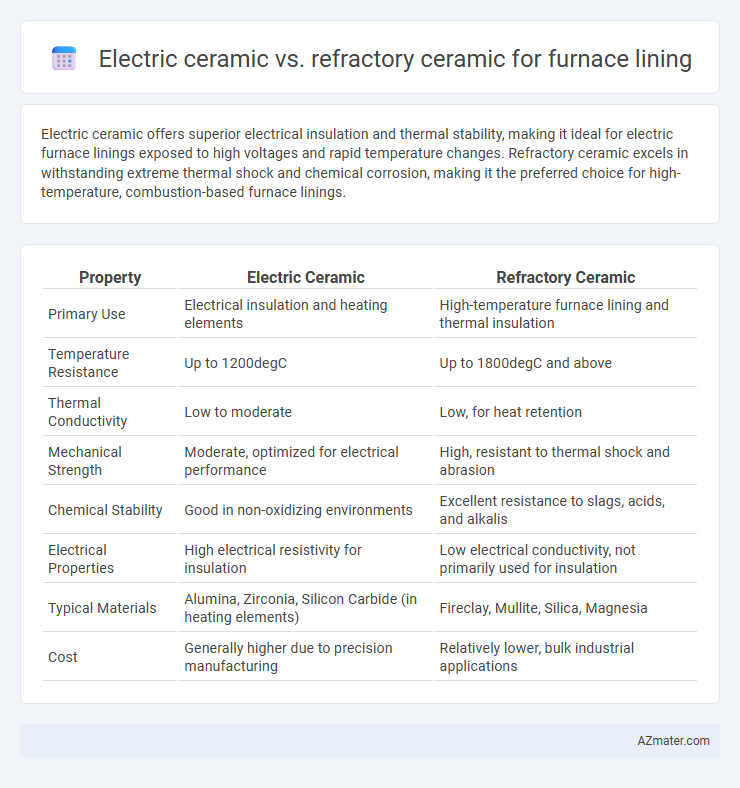Electric ceramic offers superior electrical insulation and thermal stability, making it ideal for electric furnace linings exposed to high voltages and rapid temperature changes. Refractory ceramic excels in withstanding extreme thermal shock and chemical corrosion, making it the preferred choice for high-temperature, combustion-based furnace linings.
Table of Comparison
| Property | Electric Ceramic | Refractory Ceramic |
|---|---|---|
| Primary Use | Electrical insulation and heating elements | High-temperature furnace lining and thermal insulation |
| Temperature Resistance | Up to 1200degC | Up to 1800degC and above |
| Thermal Conductivity | Low to moderate | Low, for heat retention |
| Mechanical Strength | Moderate, optimized for electrical performance | High, resistant to thermal shock and abrasion |
| Chemical Stability | Good in non-oxidizing environments | Excellent resistance to slags, acids, and alkalis |
| Electrical Properties | High electrical resistivity for insulation | Low electrical conductivity, not primarily used for insulation |
| Typical Materials | Alumina, Zirconia, Silicon Carbide (in heating elements) | Fireclay, Mullite, Silica, Magnesia |
| Cost | Generally higher due to precision manufacturing | Relatively lower, bulk industrial applications |
Introduction to Furnace Lining Materials
Electric ceramic and refractory ceramic are critical materials used in furnace lining, each designed to withstand extreme temperatures and thermal shock. Electric ceramics offer superior electrical insulation and high thermal conductivity, making them ideal for electric furnaces, whereas refractory ceramics provide excellent chemical stability and mechanical strength for traditional fuel-fired furnaces. The choice between electric and refractory ceramics depends on specific furnace operating conditions and required resistance to thermal and chemical stresses.
Overview of Electric Ceramic
Electric ceramic used in furnace lining offers superior electrical insulation and thermal stability compared to conventional refractory ceramics. It typically features enhanced resistance to electrical conductivity, making it ideal for applications requiring dielectric strength under high temperatures. These properties enable electric ceramics to improve furnace efficiency and lifespan by minimizing energy loss and maintaining structural integrity in electrically heated environments.
Overview of Refractory Ceramic
Refractory ceramics, designed to withstand extreme temperatures and corrosive environments, are critical for furnace lining due to their high thermal stability, mechanical strength, and resistance to thermal shock. These materials typically consist of alumina, silica, or zirconia, providing excellent insulation and durability under continuous high-temperature exposure. Unlike electric ceramics, refractory ceramics prioritize resistance to chemical attack and mechanical wear, ensuring longer lifespan and enhanced performance in industrial furnace applications.
Key Properties Comparison
Electric ceramic furnace linings offer high electrical insulation, superior thermal shock resistance, and excellent energy efficiency, making them ideal for electric furnaces requiring precise temperature control. Refractory ceramics provide exceptional mechanical strength, chemical stability at ultra-high temperatures, and durability under aggressive slag and metal exposure, suitable for blast furnaces and metallurgical applications. The key property distinction lies in electric ceramics' optimized electrical insulation versus refractory ceramics' enhanced thermal and chemical resilience for demanding industrial furnace environments.
Thermal Efficiency and Heat Resistance
Electric ceramics used in furnace linings exhibit superior thermal efficiency due to their excellent electrical insulation and low heat loss properties, enabling precise temperature control and energy savings. Refractory ceramics demonstrate exceptional heat resistance, maintaining structural integrity at extremely high temperatures exceeding 1600degC, which is critical for furnaces in metallurgy and glass production. Selecting electric ceramics optimizes energy consumption, while refractory ceramics ensure durability and performance under intense thermal stress.
Durability and Lifespan
Electric ceramic linings for furnaces offer enhanced thermal shock resistance and electrical insulation properties, making them ideal for high-temperature electric furnace applications. Refractory ceramics provide superior chemical stability and can withstand extreme temperatures over prolonged periods, resulting in longer overall lifespan in aggressive furnace environments. Durability of refractory ceramics typically exceeds electric ceramics in durability, especially in continuous high-temperature operations, ensuring reduced maintenance and replacement frequency.
Cost and Installation Factors
Electric ceramic linings for furnaces generally offer lower initial installation costs due to simpler handling and faster curing times compared to refractory ceramics. Refractory ceramic materials, while more expensive upfront, provide superior thermal resistance and longer service life that can reduce overall maintenance costs. Installation of refractory ceramics requires skilled labor and longer downtime, impacting operational costs more significantly than electric ceramics.
Performance in Industrial Applications
Electric ceramic furnace linings offer superior electrical insulation and thermal shock resistance, making them ideal for high-temperature industrial processes requiring precise temperature control. Refractory ceramics excel in mechanical strength and chemical stability, providing exceptional durability under extreme thermal cycling and corrosive environments. Performance in industrial applications depends on specific requirements, with electric ceramics favored for electrical efficiency and refractory ceramics preferred for structural integrity and longevity.
Environmental Impact and Safety
Electric ceramic linings in furnaces offer superior environmental benefits due to their lower energy consumption and reduced greenhouse gas emissions compared to refractory ceramics, which often require higher firing temperatures. Refractory ceramic materials may release harmful dust and gases during installation and maintenance, posing greater safety risks, whereas electric ceramics typically produce fewer airborne contaminants, enhancing workplace safety. Both materials provide thermal insulation, but electric ceramics contribute to a cleaner process with a smaller carbon footprint and lower occupational hazards.
Conclusion: Choosing the Right Ceramic for Your Furnace
Electric ceramic offers superior electrical insulation and thermal shock resistance, making it ideal for high-voltage furnace applications. Refractory ceramic provides exceptional heat retention and chemical stability at extreme temperatures, suitable for furnaces requiring prolonged high-temperature exposure. Selecting the right ceramic depends on balancing electrical insulation needs and thermal endurance to optimize furnace performance and longevity.

Infographic: Electric ceramic vs Refractory ceramic for Furnace lining
 azmater.com
azmater.com